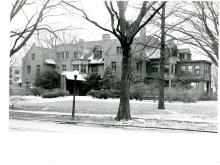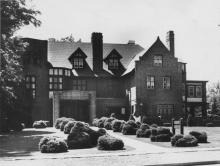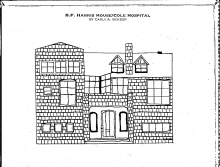In the early 1900s, the Burnham-Harris Mansion at the corner of Prospect and Church in Champaign was one of the best addresses in town. Located at 809 W. Church Street, it was the hub of social life in Champaign, and an invitation to an event there was always a coveted ticket.
By February 1947, all that had changed, when the Harris Mansion sold to Professor and Mrs. David Cole. The couple purchased the long-neglected property for around $50,000, intending to convert the 25 room mansion into a convalescent hospital. Although the property was located in a residential area, the plan was quickly accepted and approved by the planning commission.
Based on a lack of negative local input, it seems that the neighbors didn't seem to mind the change in building use, and the City of Champaign Mayor, George Babb, also welcomed the hospital because "all of the present hospitals are continually filled to capacity."
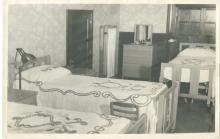 The challenge then became how to retrofit a private 25 room mansion into a 50 bed, two operating room convalescent hospital. According to an architectural study done by Brent Mathers in 1994, the building's exterior did not change much at first, except for retrofitting the portico entrance to serve as the main public entrance to the building. The more significant changes were internal, requiring extensive remodeling of all public spaces while leaving most of the 2nd and 3rd-floor bedrooms intact. Adding extra bathrooms and storage was also necessary to accommodate the expected 50 patients.
The challenge then became how to retrofit a private 25 room mansion into a 50 bed, two operating room convalescent hospital. According to an architectural study done by Brent Mathers in 1994, the building's exterior did not change much at first, except for retrofitting the portico entrance to serve as the main public entrance to the building. The more significant changes were internal, requiring extensive remodeling of all public spaces while leaving most of the 2nd and 3rd-floor bedrooms intact. Adding extra bathrooms and storage was also necessary to accommodate the expected 50 patients.
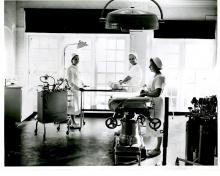 Additionally, the billiard room was converted into a conference hall, and the outdoor pool was declared a neighborhood hazard and filled in. The gardens were considered an important convalescent tool, so they were left intact and regularly maintained. The construction and retrofitting moved quickly, and the hospital opened on August 6, 1947. The Coles moved into an apartment created for them in the 3rd-floor ballroom so they could be onsite at all times.
Additionally, the billiard room was converted into a conference hall, and the outdoor pool was declared a neighborhood hazard and filled in. The gardens were considered an important convalescent tool, so they were left intact and regularly maintained. The construction and retrofitting moved quickly, and the hospital opened on August 6, 1947. The Coles moved into an apartment created for them in the 3rd-floor ballroom so they could be onsite at all times.
Some exterior changes were made to the building over the years, with the most substantial changes coming in the 1960s as the rear side of the building was extensively changed into small offices. The carriage house was remodeled into an operating room.
Inside the building, the great hall, long a centerpiece of the building, was modernized to serve as a waiting room, and the main front entrance was enlarged and enclosed. As the years went on, many other changes were put in place as patient expectations, and medical advancements progressed.
The expansions of other local medical facilities, Burnham, Mercy, and Carle, negatively impacted Cole. By the mid-1980s, the problems had piled up, and in 1987 Cole Hospital’s medical clinic merged with Carle Hospital, and soon after that, the remaining administration of Cole Hospital filed for bankruptcy.
Cole Hospital lasted 40 years, and while the venture started strong and was welcome in the community, it turned out to be unsustainable. Today the building houses The Pavilion Behavioral Health System, which specializes in mental health and substance abuse treatment.
- Ann Panthen
Archives Assistant

